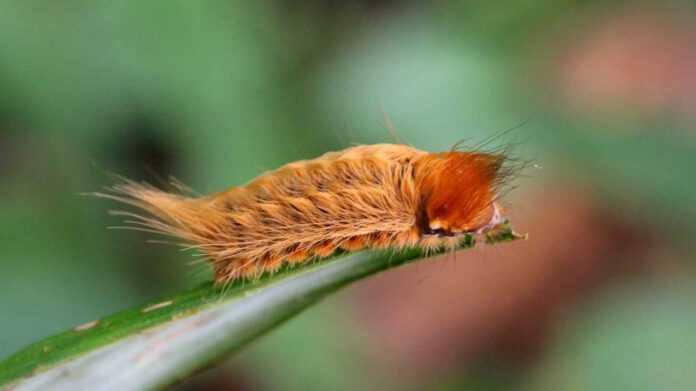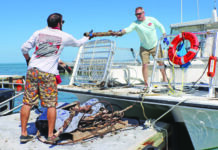There are many pleasures to be found on our island for cats and dogs—chickens to chase, lizards to hunt, popcorn to pick up from the sidewalk in front of the Green Parrot. But there are also perils, many of which are in plain sight. Here are a few:
Heat
It’s obvious, right? The Keys are hotter than most places in the United States due to our proximity to the equator. And in the summer, not only is the sun more intense, but the sub-tropical atmosphere is even more humid than usual. This double whammy ramps up the seriousness of heat risks to pets. Dogs and cats pant to evaporate moisture and take heat away from their body. If the humidity is too high, they are unable to cool themselves and their temperature can skyrocket to dangerous levels—very quickly.
In dogs, look for warning signs such as excessive panting, glazed eyes, salivation, and rapid heartbeat. If you notice any of these signs, get them into air conditioning immediately and monitor them closely. While heatstroke is less common in cats, felines can be affected by heat, especially long-haired kitties or short-snouted cats such as Persians. Notice if your cat is panting. This can be normal on an extremely hot day, but constant or very heavy panting in a cat means they are much too hot—and could indicate the start of heat stroke.
The best prevention is to keep your fur babies cool. Pay attention to your pets whenever they are outside on hot days. If they look too hot or in distress, get them out of the heat. Add a cool compress to their bellies and paws. And if symptoms persist, take them to a vet.
TOXIC PLANTS
My dog’s motto, like most of his kind, is “eat first, ask questions later.” This extends to the flowers and hanging fronds we pass by on our walks. It’s never a good idea to let your pet munch his way through flora and fauna here. Many specimens of beautiful and lush greenery in paradise can cause illness or even death.
There are numerous plants that can make your animal sick. Keep your pets away from the following popular plants, found in our gardens and along our streets:

Sago Palm: This distinctive palm is a stunner in tropical landscapes but looks are deceiving. The entire tree, including seeds and fronds, is toxic to dogs. Sagos are easily identifiable by their thick, textured trunk that resembles a wide, squat pineapple. They range from 3 to 10 feet in height. The danger is in ingestion, so while a tinkle on the bark won’t harm them, eating any part might. Best to keep your dog from getting too close.
Desert Rose: Walking around town, you’ll notice many containers and plant beds containing a distinctive small tree with pink flowers and succulent leaves. With its year-round flowering and low maintenance, the desert rose is a popular, decorative choice for many Keys homes. But if you’re a pet owner, don’t be tempted to plant it or let your animals go near it. The desert rose is toxic to your dog or cat if ingested or even licked.
Lantana: This popular hot weather plant with its bursts of pink, orange, and yellow flower clusters is widely available in most garden centers. But beware of its charms. All parts of the plant are poisonous to dogs and cats if ingested, especially the leaves and green berries. While most pets don’t ingest enough of the berries to cause death, it can cause severe stomach upset and worse.
CATERPILLARS AND TOADS
Snakes and gators are not the only dangers lurking on the ground here. These little critters can cause big trouble for your pet.
Puss Caterpillar: This hairy-looking piece of fluff is one of the most venomous caterpillars in Florida. Recently, it has been seen in the Keys, where it drops out of trees in spring and fall. Measuring about an inch long, the insect is covered in hair-like bristles with an orange streak frequently running down its back. According to the Fish & Wildlife Foundation of Florida, the caterpillar’s attractive hairs hide “extremely toxic spines” that stick to the skin of your pets. The sting can be incredibly painful. Spines can be pulled out with cellophane tape, but take care not to touch it yourself or you’ll all be howling.
Bufo Toads: One of the pleasures of walking a dog on rainy evenings in Key West is hearing frogs celebrating a wet world. But don’t let Fido investigate pop-up ponds or standing water too closely. There is always the possibility of running into the extremely dangerous Bufo toad. About 4 to 6 inches long with reddish-brown to olive-gray coloring, the Bufo toad’s call is unique, with a chorus that sounds like an idling diesel engine. Most canine exposure to this toad occurs in the early morning or late evening hours after periods of rain. While generally harmless to people, if a dog bites or swallows them, chemicals are released that can result in sickness and death in as little as 15 minutes without proper treatment.
If you suspect your animal has made contact with a Bufo toad, wash toxins out of their mouth using a hose or wet washcloth for 10 minutes. And get your dog to a vet asap. Accidents can happen at the worst possible times. If your animal is in crisis outside business hours, Cruz Animal Hospital on Ramrod Key provides emergency veterinary care for the entire Florida Keys 24/7. I suggest putting their number in your contacts just in case.
So, remember, this ain’t Disneyland. The Keys are beautiful, but also wild under the manicured exterior. No matter how intoxicating it is to simply be here, don’t forget to keep an eye out for your pets. You want them to enjoy paradise as much as you do.



























